A Self-Powered, Threshold-Based Wireless Sensor for the Detection of Floor Vibrations
Abstract
1. Introduction
2. Development of a Cantilever-Type Piezoelectric Energy Harvester
2.1. Testbed and Dynamic Characteristics of the Slab
2.2. Design of the Cantilever-Type Piezoelectric Energy Harvester
3. Correlation Study
4. Demonstration of the Self-Powered Wireless Sensor for Floor Vibration Detection
5. Conclusions
Author Contributions
Funding
Conflicts of Interest
References
- Kim, T.; Ramos, C.; Mohammed, S. Smart City and IoT. Future Gener. Comput. Syst. 2017, 76, 159–162. [Google Scholar] [CrossRef]
- Krishna, R.; Kummitha, R.; Crutzen, N. How do we understand smart cities? An evolutionary perspective. Cities 2017, 67, 43–52. [Google Scholar]
- Najafi-Ghalelou, A.; Zare, K.; Nojavan, S. Optimal scheduling of multi-smart buildings energy consumption considering power exchange capability. Sustain. Cities Soc. 2018, 41, 73–85. [Google Scholar] [CrossRef]
- Marinakis, V.; Doukas, H. An advanced IoT-based System for Intelligent Energy Management in Buildings. Sensors 2018, 18, 610. [Google Scholar] [CrossRef] [PubMed]
- Lam, M.; Mirshekari, M.; Pan, S.; Zhang, P.; Noh, H.Y. Robust Occupant Detection through Step-Induced Floor Vibration by Incorporating Structural Characteristics. Dyn. Coupled Struct. 2016, 4, 357–367. [Google Scholar]
- Mun, D.; Park, H.; Hwang, J. Prediction of Concrete Slab Acceleration and Floor Impact Noise Using Frequency Response Function. Trans. Korean Soc. Noise Vib. Eng. 2014, 24, 483–492. [Google Scholar] [CrossRef][Green Version]
- Kim, K.Y.; Chung, J.Y.; Yeon, J.O.; Kim, M.J. Analysis of Floor Impact Sound Propagation around the Adjacent House. Appl. Mech. Mater. 2015, 752–753, 745–748. [Google Scholar] [CrossRef]
- Lee, P.; Jeong, J.; Park, J.; Jeon, J. Comparison of Standard Floor Impact Sources with Human Impact Source. Trans. Korean Soc. Noise Vib. Eng. 2006, 8, 789–796. [Google Scholar]
- Jeon, J.Y.; Ryu, J.K.; Jeong, J.H.; Tachibana, H. Review of the Impact Ball in Evaluating Floor Impact Sound. Acta Acust. United Acust. 2006, 92, 777–786. [Google Scholar]
- Lee, S.; Youn, B.D.; Jung, B.D. Robust segment-type energy harvester and its application to a wireless sensor. Smart Mater. Struct. 2009, 18, 095021. [Google Scholar] [CrossRef]
- Roundy, S.; Wright, P.K.; Rabaey, J.M. Energy Scavenging for Wireless Sensor Networks: With Special Focus on Vibrations; Springer: Berlin, Germany, 2004. [Google Scholar]
- Kim, H.S.; Kim, J.-H.; Kim, J. A review of piezoelectric energy harvesting based on vibration. Int. J. Precis. Eng. Manuf. 2011, 12, 1129–1141. [Google Scholar] [CrossRef]
- Yoon, H.; Youn, B.D.; Kim, H.S. Kirchhoff plate theory based electromechanically-coupled analytical model considering inertia and stiffness effects of a surface-bonded piezoelectric patch. Smart Mater. Struct. 2016, 25, 025017. [Google Scholar] [CrossRef]
- Erturk, A.; Inman, D.J. An experimentally validated bimorph cantilever model for piezoelectric energy harvesting from base excitations. Smart Mater. Struct. 2009, 18, 25009–25018. [Google Scholar] [CrossRef]
- Kim, J.E.; Kim, H.; Yoon, H.; Kim, Y.Y.; Youn, B.D. An Energy conversion model for cantilevered piezoelectric vibration energy harvesters using only measurable parameters. Int. J. Precis. Eng. Manuf.-Green Technol. 2015, 2, 51–57. [Google Scholar] [CrossRef][Green Version]
- Roundy, S.; Kright, P.K. A piezoelectric vibration based generator for wireless electronics. Smart Mater. Struct. 2004, 13, 1131–1142. [Google Scholar] [CrossRef]
- Sodano, H.A.; Park, G.; Inman, D.J. Estimation of Electric Charge Output for Piezoelectric Energy Harvesting. Strain 2004, 40, 49–58. [Google Scholar] [CrossRef]
- Chen, S.N.; Wang, G.J.; Chien, M.C. Analytical modeling of piezoelectric vibration-induced micro power generator. Mechatronics 2006, 16, 379–387. [Google Scholar] [CrossRef]
- Goldschmidtboeing, F.; Woias, P. Characterization of different beam shapes for piezoelectric energy harvesting. J. Micromech. Microeng. 2008, 18, 104013. [Google Scholar] [CrossRef]
- Hehn, T.; Hagedorn, F.; Maurath, D.; Marinkovic, D.; Kuehne, I.; Frey, A.; Manoli, Y. A Fully Autonomous Integrated Interface Circuit for Piezoelectric Harvesters. IEEE J. Solid-State Circuits 2012, 47, 2185–2198. [Google Scholar] [CrossRef]
- Gasnier, P.; Willemin, J.; Boisseau, S.; Despesse, G.; Condemine, C.; Gouvernet, G.; Chaillout, J. An Autonomous Piezoelectric Energy Harvesting IC Based on a Synchronous Multi-Shot Technique. IEEE J. Solid-State Circuits 2014, 49, 1561–1570. [Google Scholar] [CrossRef]
- Quelen, A.; Morel, A.; Gasnier, P.; Grézaud, R.; Monfray, S.; Pillonnet, G. A 30 nA quiescent 80 nW to 14 mW power-range shock-optimized SECE-based piezoelectric harvesting interface with 420% harvested energy improvement. In Proceedings of the IEEE International Solid State Circuits Conference, San Francisco, CA, USA, 11–15 February 2018; pp. 150–152. [Google Scholar]
- Analog Sensor Node. Available online: http://www.ambiosystems.com/ (accessed on 22 July 2018).
- Piezo Systems Product Catalog. Available online: http://piezo.com/ (accessed on 22 July 2018).
- Video of Feasibility Demonstration. Available online: https://youtu.be/fliSTD6A0G8 (accessed on 31 August 2018).
- Jeon, J.Y.; Lee, P.J.; Sato, S. Use of the standard rubber ball as an impact source with heavyweight concrete floors. J. Acoust. Soc. Am. 2009, 126, 167–178. [Google Scholar] [CrossRef] [PubMed]
- Jung, B.C.; Yoon, H.; Oh, H.; Lee, G.; Yoo, M.; Youn, B.D.; Huh, Y.C. Hierarchical model calibration for designing piezoelectric energy harvester in the presence of variability in material properties and geometry. Struct. Multidiscip. Optim. 2016, 53, 161–173. [Google Scholar] [CrossRef]
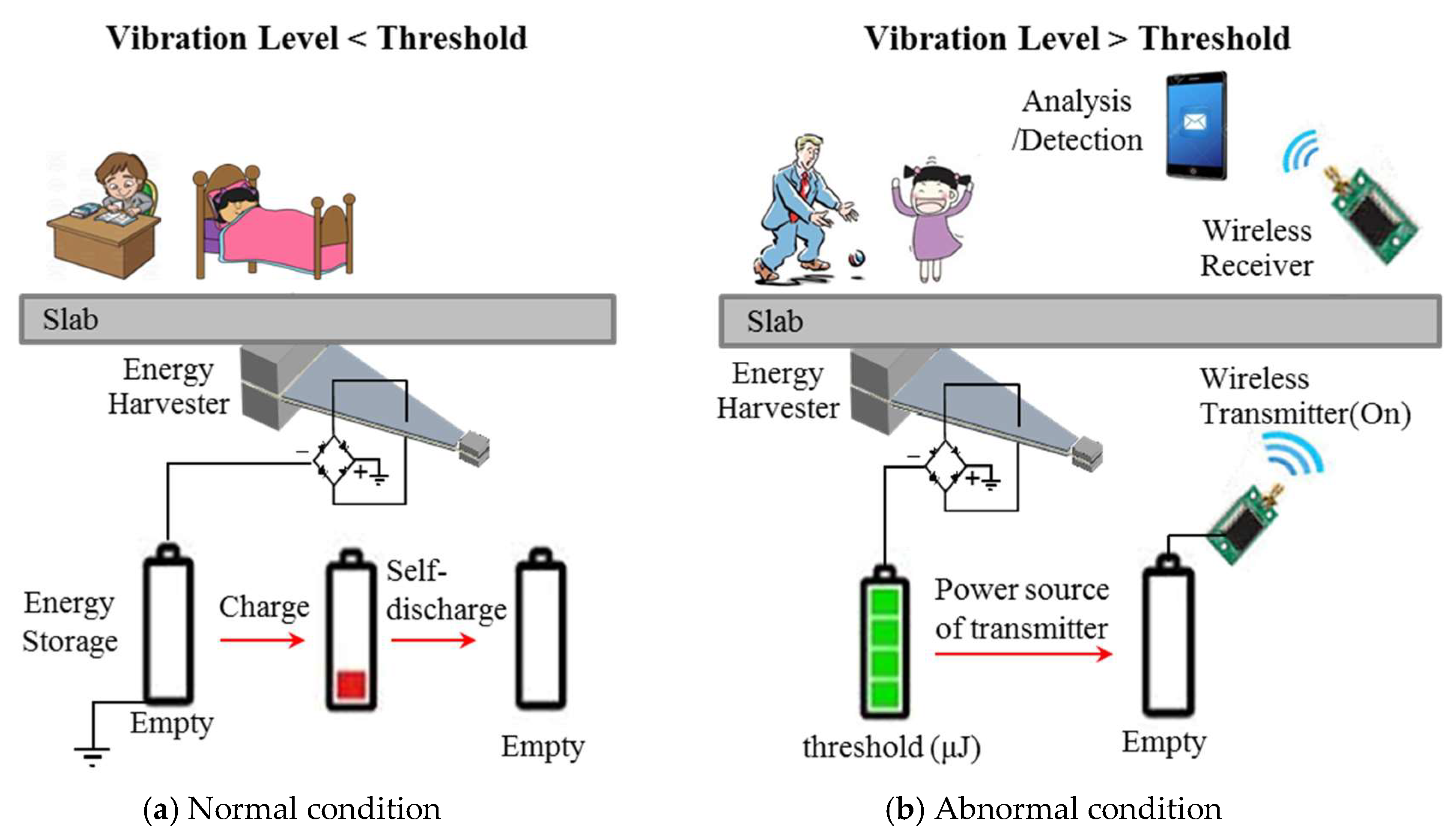
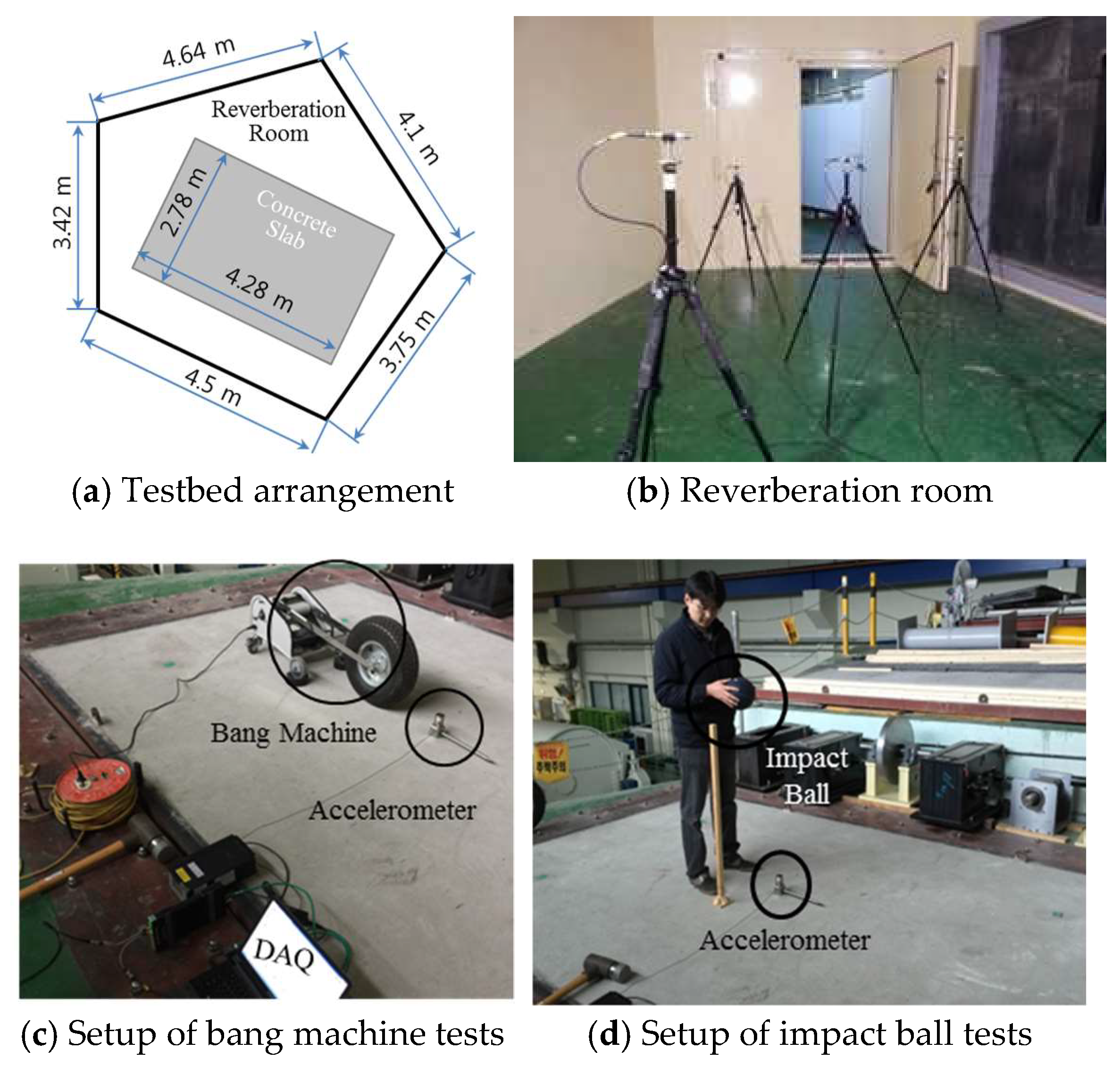


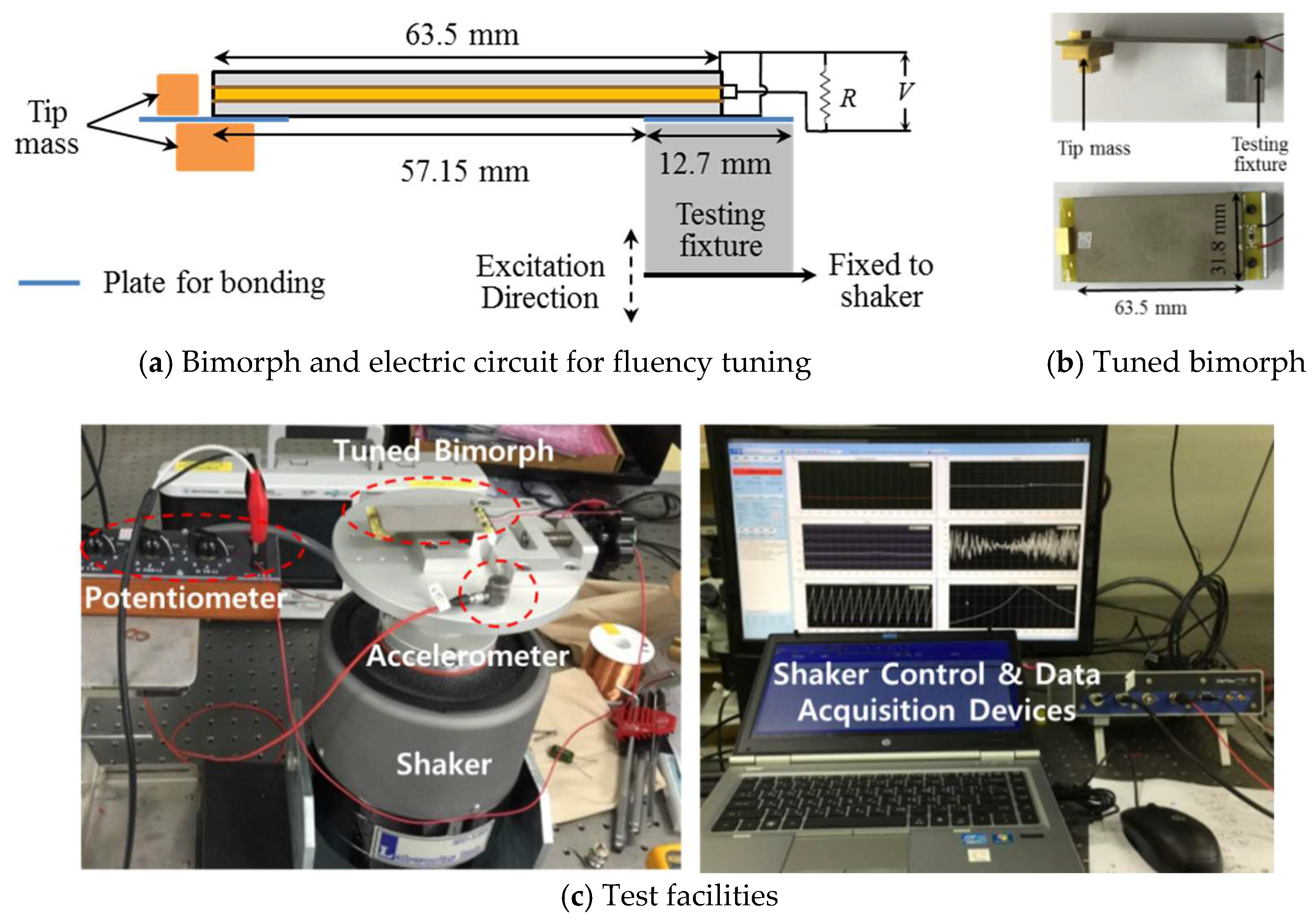
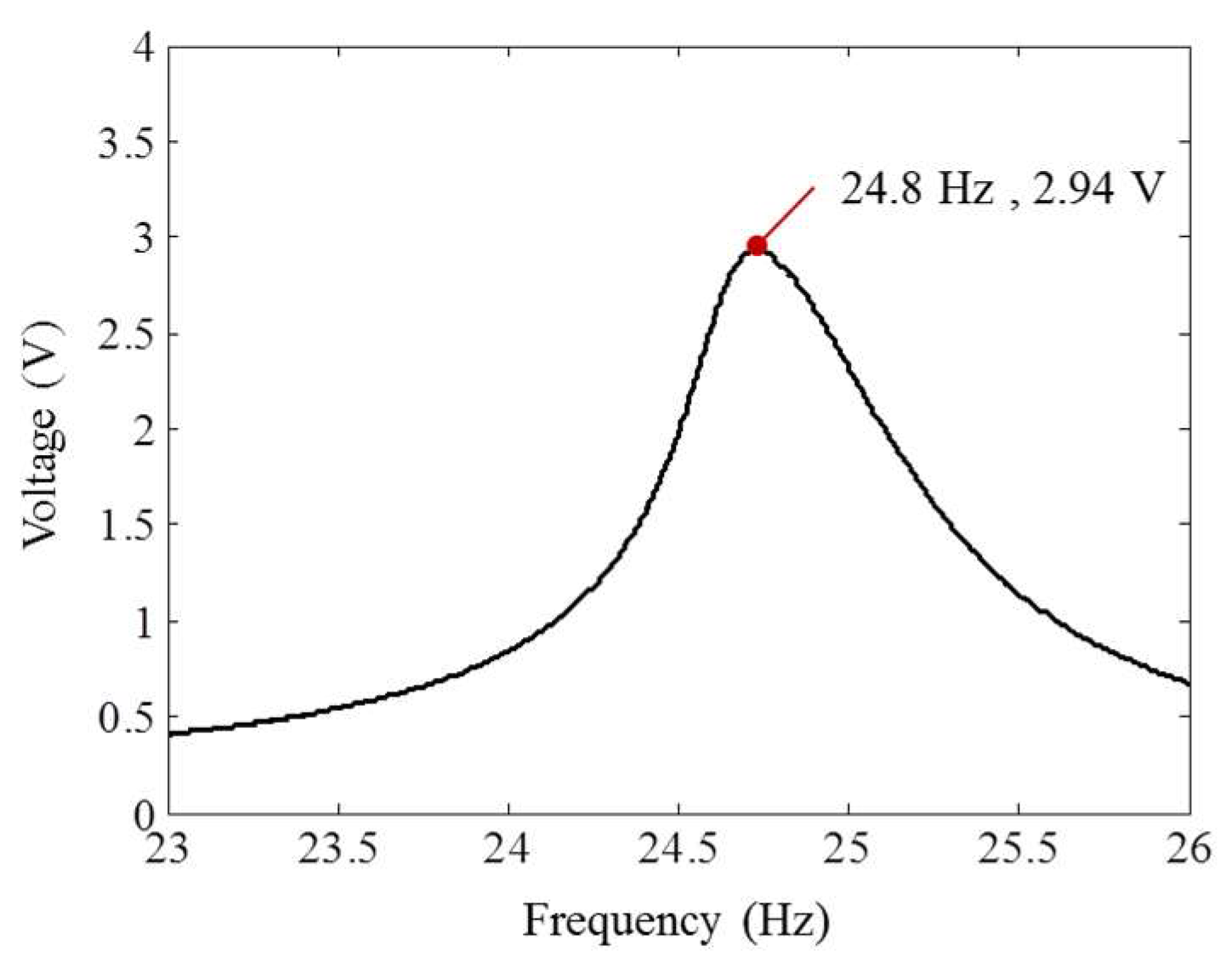
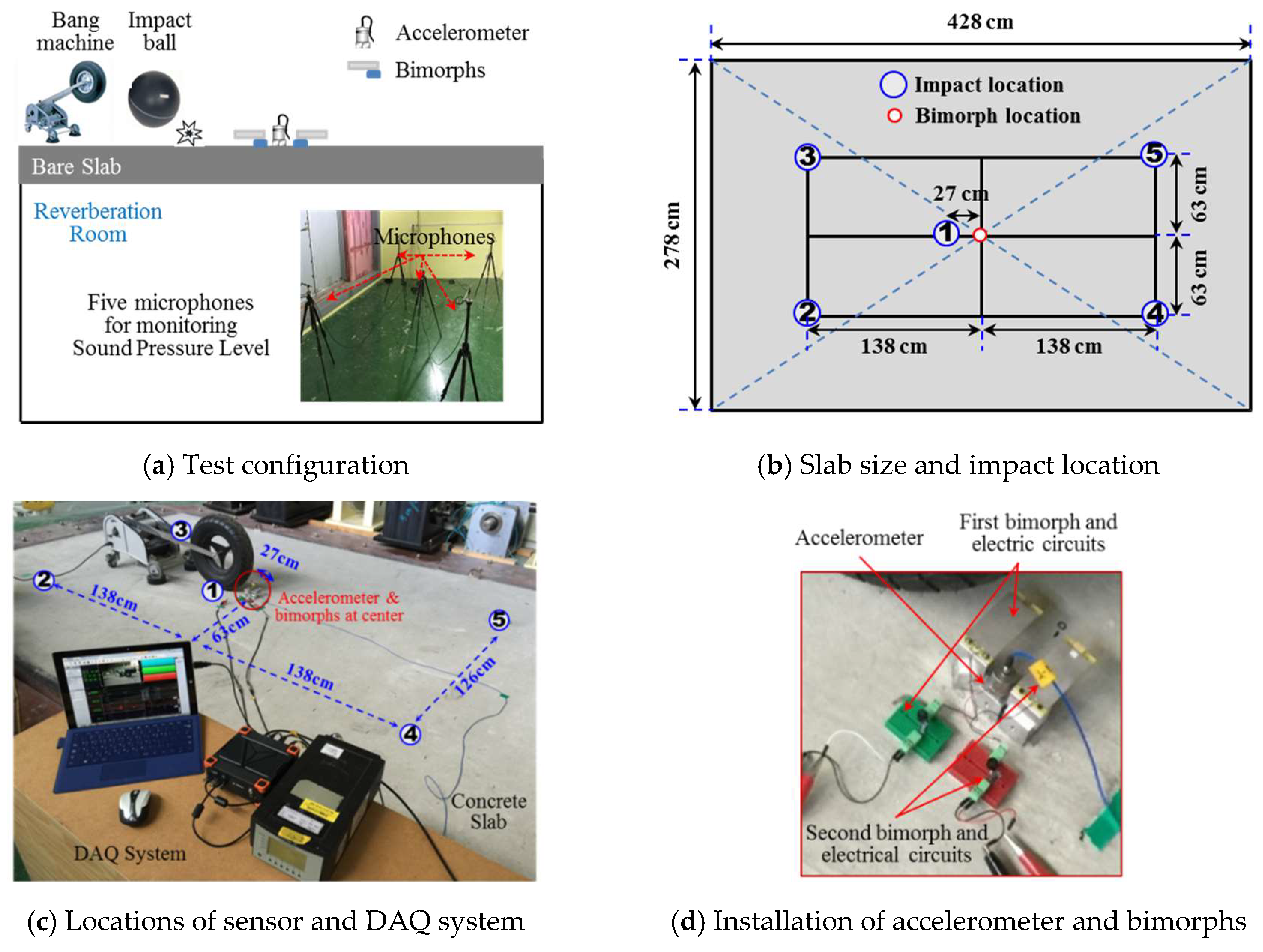
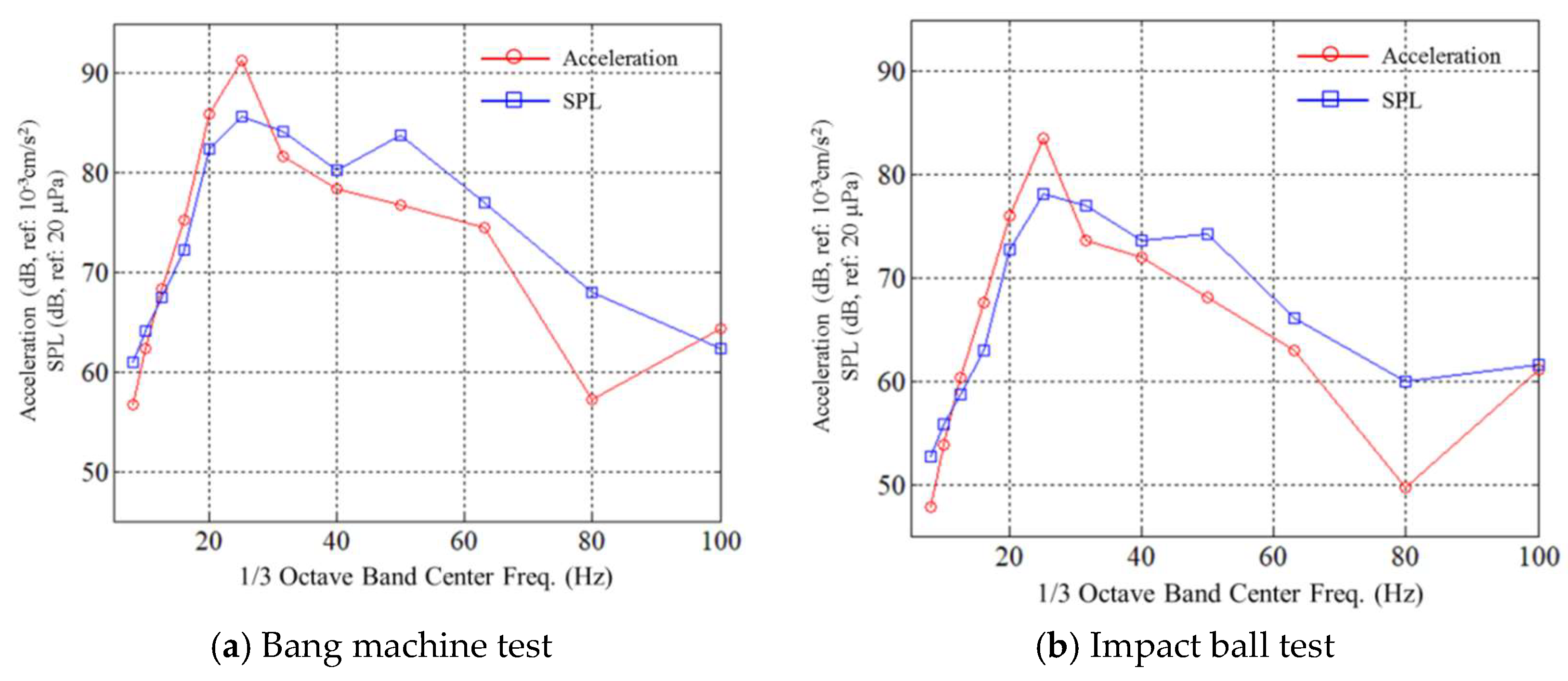

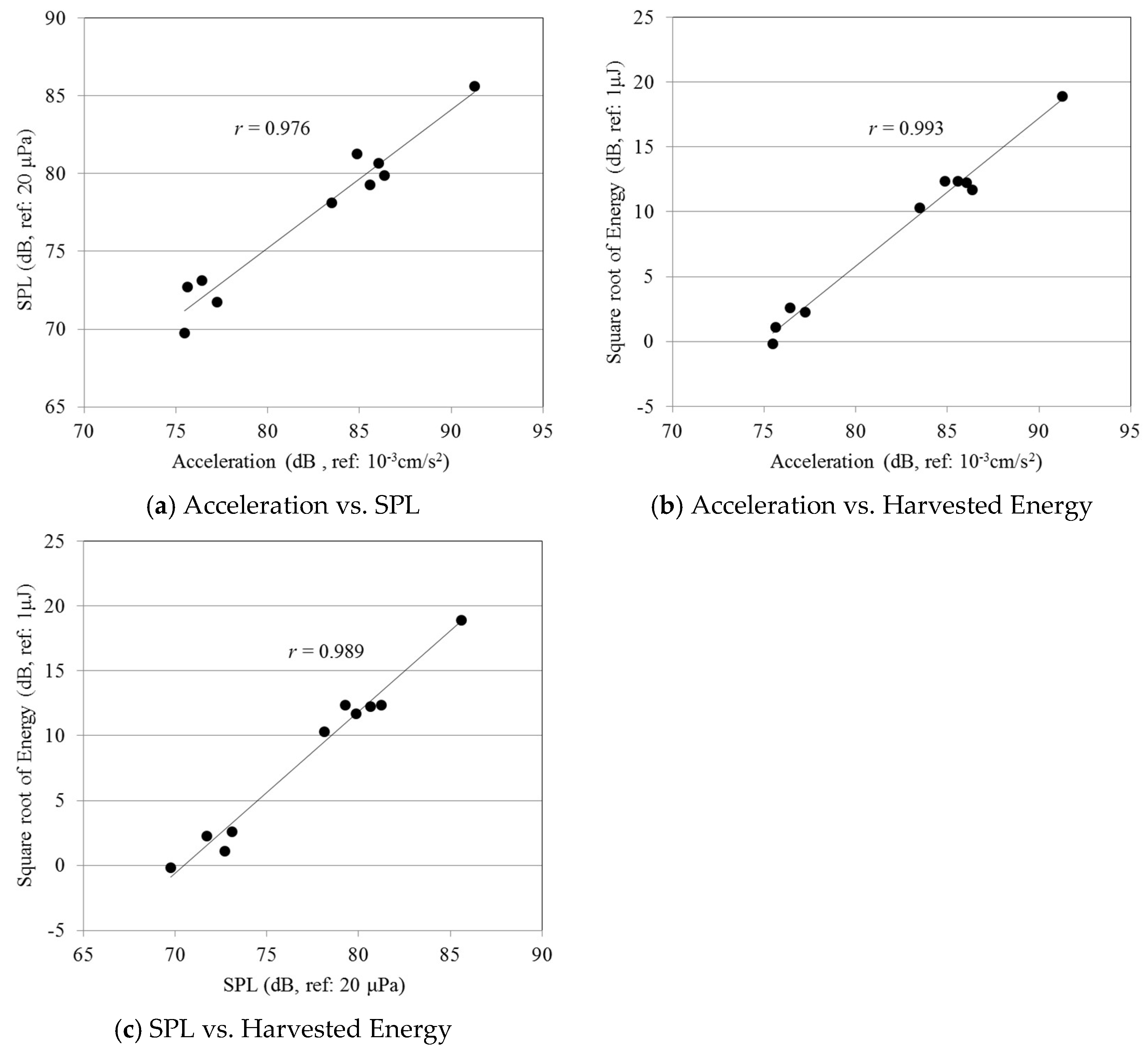
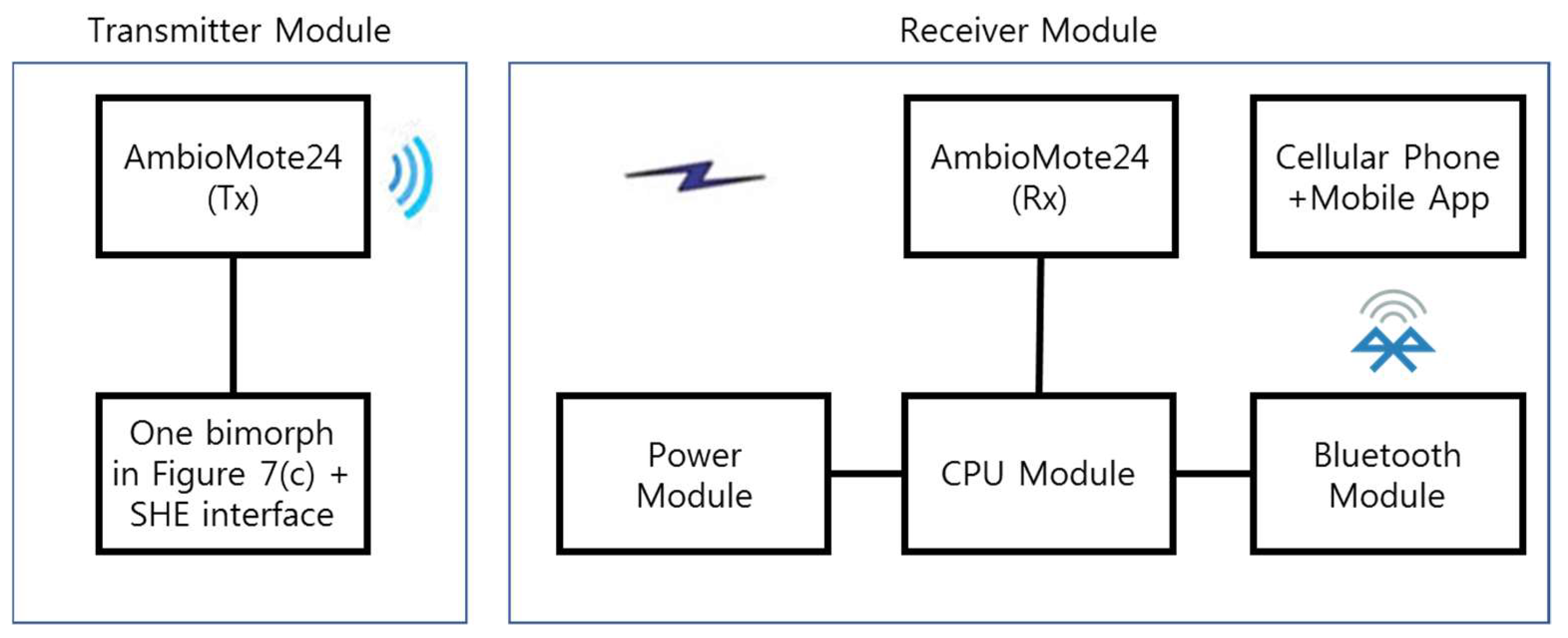
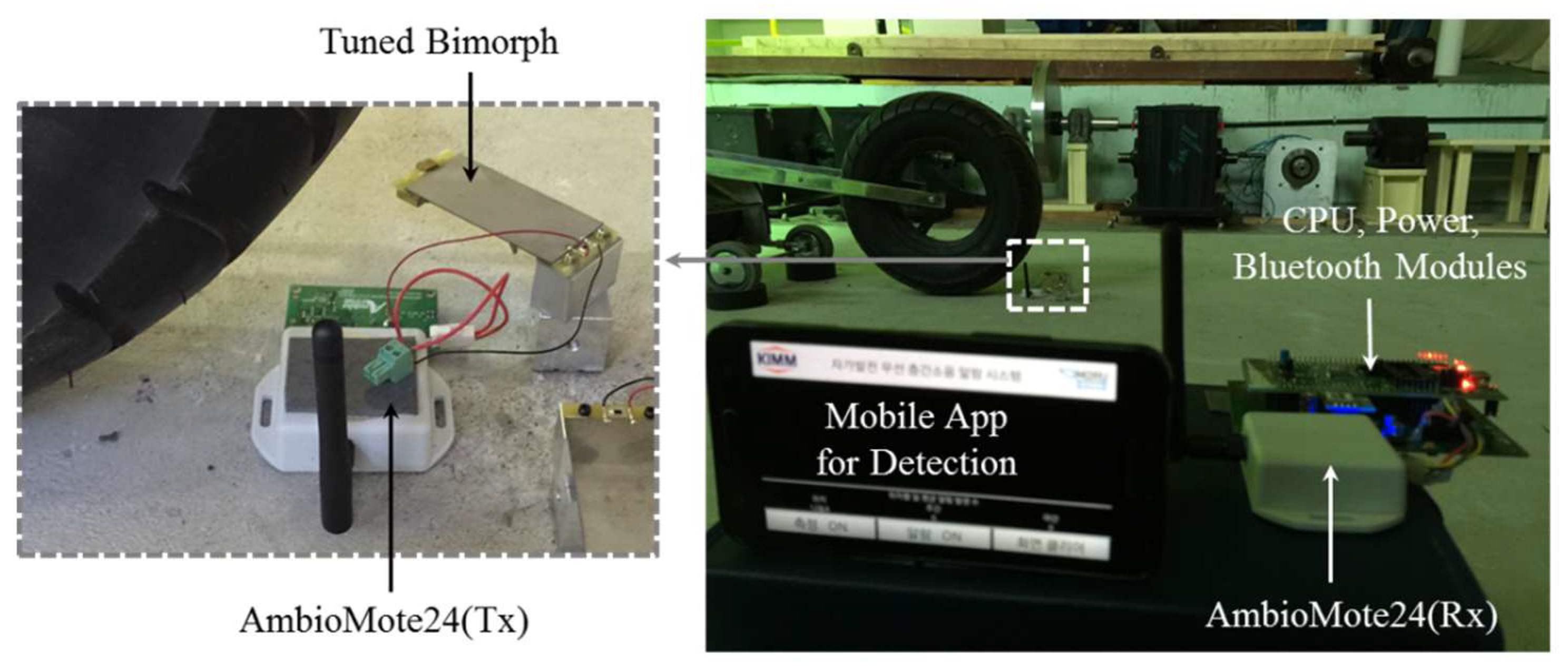
| Impact Source | Natural Frequency of Slab | Acceleration (Peak to Peak) | Time Duration of Slab Vibration | |
|---|---|---|---|---|
| Bang machine | 24.8 Hz | −3.0 m/s2 ~4.0 m/s2 | ≈0.8 s | |
| Drop height | 0.85 m | |||
| Tire pressure | 240 kPa | |||
| Impact force (peak) | ≈4000 N | |||
| Time duration | ≈20 ms | |||
| Impact ball | 24.8 Hz | −1.17 m/s2 ~1.55 m/s2 | ≈0.6 s | |
| Drop height | 1 m | |||
| Impact force (peak) | ≈1500 N | |||
| Time duration | ≈20 ms | |||
| Specification | Value |
|---|---|
| Model number | D220-A4-503YB |
| Piezo material | PZT-5A |
| Size of a base specimen | 63.5 × 31.8 mm |
| Active length of the bimorph (Figure 5a) | 57.15 mm |
| Weight | 10.4 gram |
| PZT thickness | 0.019 mm |
| Brass thickness | 0.013 mm |
| Capacitance | 232 μF |
| Natural frequency (without mass) | 52 Hz |
| Impact Machine | Impact Location | Distance from Accelerometer & Bimorph | Harvested Energy (Average of Two Bimorphs) (μJ) | Square Root of Harvested Energy (dB, Ref.:1 μJ)) | Acceleration at 25 Hz (dB, Ref.: 10−3 cm/s2) | SPL at 25 Hz (dB, Ref.: 20 μPa) |
|---|---|---|---|---|---|---|
| Impact Ball | ① | 27 cm | 10.75 | 10.31 | 83.50 | 78.13 |
| Bang Machine | ① | 27 cm | 78.11 | 18.93 | 91.29 | 85.62 |
| Impact Ball | ① | 151.7 cm | 0.95 | −0.22 | 75.46 | 69.77 |
| Bang Machine | ① | 151.7 cm | 17.29 | 12.38 | 85.59 | 79.30 |
| Impact Ball | ① | 151.7 cm | 1.69 | 2.27 | 77.23 | 71.73 |
| Bang Machine | ① | 151.7 cm | 14.83 | 11.71 | 86.36 | 79.88 |
| Impact Ball | ① | 151.7 cm | 1.28 | 1.09 | 75.65 | 72.70 |
| Bang Machine | ① | 151.7 cm | 17.20 | 12.36 | 84.87 | 81.25 |
| Impact Ball | ① | 151.7 cm | 1.82 | 2.60 | 76.43 | 73.12 |
| Bang Machine | ① | 151.7 cm | 16.77 | 12.25 | 86.05 | 80.65 |
| Factors | Correlation Coefficient |
|---|---|
| Acceleration vs. Sound Pressure Level | 0.976 |
| Acceleration vs. Harvested Energy | 0.993 |
| Sound Pressure Level vs. Harvested Energy | 0.989 |
| Module | Main Specifications |
|---|---|
| AmbioMote24 | AmbioSYSTEMS AmbioMote24-A |
| Frequency band: 2.4 GHz | |
| ADC Convert resolution: 10 bit | |
| Capacitance: 0.5 μ | |
| Communication distance: up to 80 m | |
| Data transmission rate(Tx): 10 Hz | |
| CPU Module | STMicroelectronics STM32L152RCT6 |
| Clock speed: max. 32 MHz | |
| Data bus width: 32 bit | |
| Memory: 256 KB, 32 KB RAM, 8 KB ROM | |
| Bluetooth Module | Firmtech FB155BC(SPP + HID) |
| Bluetooth Version: 2.1 (2.4 GHz ISM Band) | |
| Communication distance: 10 m |
| Impact Source | Impact Location | Number of Impacts | Number of Signals Transmitted |
|---|---|---|---|
| Bang machine | ① | 1 | 7 |
| Impact ball | ① | 3 | 4 |
© 2018 by the authors. Licensee MDPI, Basel, Switzerland. This article is an open access article distributed under the terms and conditions of the Creative Commons Attribution (CC BY) license (http://creativecommons.org/licenses/by/4.0/).
Share and Cite
Jung, B.C.; Huh, Y.C.; Park, J.-W. A Self-Powered, Threshold-Based Wireless Sensor for the Detection of Floor Vibrations. Sensors 2018, 18, 4276. https://doi.org/10.3390/s18124276
Jung BC, Huh YC, Park J-W. A Self-Powered, Threshold-Based Wireless Sensor for the Detection of Floor Vibrations. Sensors. 2018; 18(12):4276. https://doi.org/10.3390/s18124276
Chicago/Turabian StyleJung, Byung C., Young Cheol Huh, and Jin-Woo Park. 2018. "A Self-Powered, Threshold-Based Wireless Sensor for the Detection of Floor Vibrations" Sensors 18, no. 12: 4276. https://doi.org/10.3390/s18124276
APA StyleJung, B. C., Huh, Y. C., & Park, J.-W. (2018). A Self-Powered, Threshold-Based Wireless Sensor for the Detection of Floor Vibrations. Sensors, 18(12), 4276. https://doi.org/10.3390/s18124276




